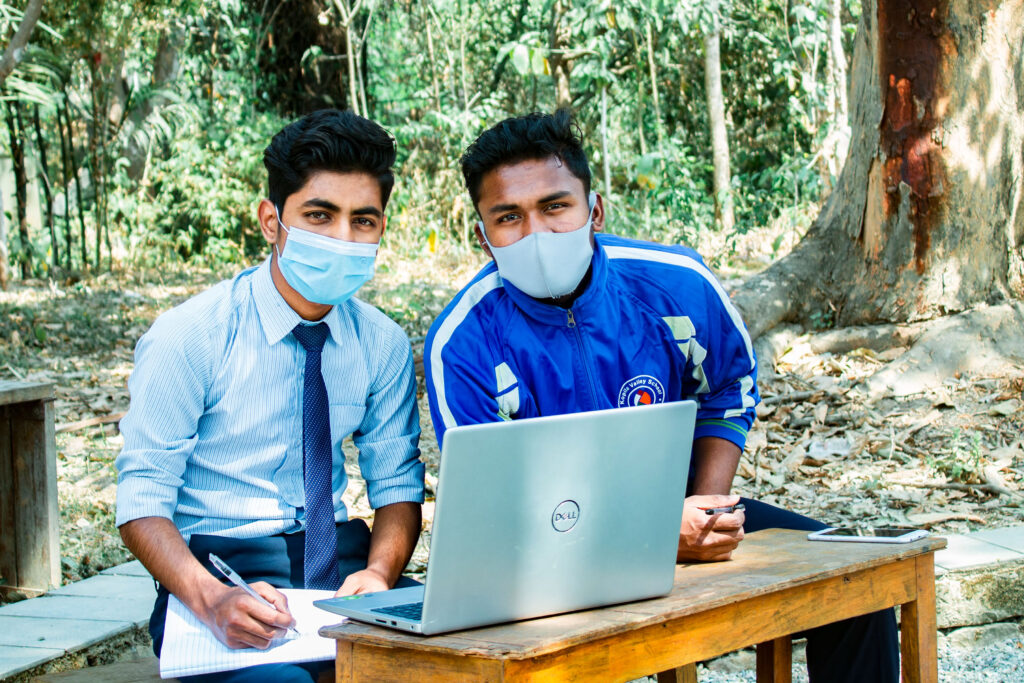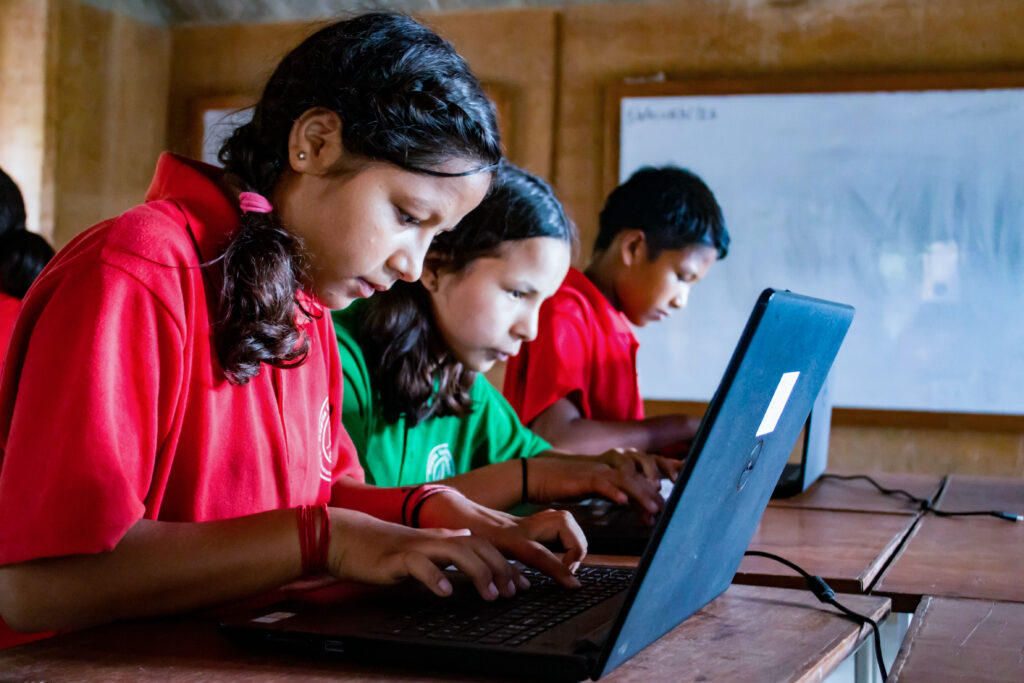Connectivity at Kopila Valley School in Nepal
BlinkNow co-founder Maggie Doyne shares about connectivity at Kopila Valley school in Nepal and how COVID-19 is affecting the digital divide there.


We started a partnership with BlinkNow after meeting co-founder Maggie Doyne in early 2020 to provide an internet connection at the Kopila Valley school in Nepal. At the time we started this partnership, none of us knew just how important connectivity would become.
Q&A with Maggie
To help us paint a picture of the effect having connectivity made on the students and teachers there, and what challenges still exist in Nepal and other countries where connectivity is not always a given, we asked Maggie to answer some questions. Her answers discuss topics such as how connectivity is used at the Kopila Valley school, the effects the COVID-19 pandemic has had on the digital divide, and what the future looks like for a more digital Kopila Valley school.
What was your plan for using the internet at Kopila Valley before COVID-19 changed priorities?
Our goal before covid hit was to leverage online learning platforms and make them more accessible to our students at different grade levels. It has also been to increase wifi accessibility across the campus (from the early childhood area, to the science lab, to the admin building and vocational site) as well as continuing to train and capacity build computer and internet skills amongst our educational team and leadership.
Across campus, WiFi was available for all staff, teachers and leadership. Our team used connectivity to create lesson plans, conduct research, participate in online training sessions, and communicate with each other via email on a lesser basis. Our students have access to wifi and the internet during their computer classes in our computer lab.
In classrooms campus-wide, the internet was primarily used to show videos or project online content for students. This varied for more advanced subjects where students were expected to conduct online research for various projects, such as their +2 Management capstone project.
What are some examples of how the internet was used?
One area where the internet and technology equipment made a life-changing difference on our students is our Futures Center. Here the internet was used to help students research opportunities for their futures. From college and university programs to career exploration, the digital connectivity of our Futures Center allowed our students to be better prepared for what lies ahead.
Some sustainability projects on campus also depend on internet connectivity. A new project – Cultivating Pathway to Sustainability – brings together international schools to share their green ideas. The learning group connects students from schools in the United States, from countries across Europe, and includes ten Kopila Valley students. They hold meetings online, select the best “green” proposals from students, and support its implementations. Having quality technology and the internet allows these students to build international relationships and stay current on global sustainability efforts.
How has the access to the internet changed what the kids are able to learn?
Access to the internet on our campus has virtually opened up the world to our students. Our teachers can incorporate diverse and interactive learning materials for our younger students, while our older students can access wider opportunities because of their access to the internet. Simply put, it opens up the world to our students. For younger students, it influences their learning. For our older students, it allows them to dream bigger, and access better resources for their futures. It also allows them to pursue various different interests they may have like learning guitar on youtube or how to code, or an art technique, a new recipe to try out when they are on dinner duty at our children’s home.
What new challenges are there now due to the increase in digital device usage?
Like all schools and families, we’re aware of the need to balance types of learning. We understand the power that digital learning has, and how much it can expand a child’s ability to learn. At the same time, we have to strike the right balance between digital and non-digital learning. We need to keep our kids safe while making sure they’re also prepared for a successful future in an increasingly digital world.
Safety is a major concern for our organization. In our community, the internet is a primary medium that leads to early marriage or eloped students. This perpetuates a cycle of poverty when these students do not complete their 10th-grade examinations. It also leads to various physical and emotional traumas. When we open up access to the internet and devices to our students, their online safety needs to be taken into utmost consideration. We address this through awareness training classes and group discussions with targeted demographics.
One of our other issues is that kids don’t have internet at their homes or access to devices. This was really hard during covid when the rest of the world had to pivot to online learning.
What do your kids use the internet for?
Students at Kopila Valley School use the internet for a variety of academic and extracurricular activities.
Many of our grade-12 students are required to complete a capstone project, which requires them to pick a topic and perform detailed research. The students used the internet to develop questionnaires, perform surveys in their community, analyze survey data and information, and present the findings using academic journals to back up their research. In our middle grade speaking class, students do internet research for their chosen speaking topics. They then deliver class presentations based on their research topics.
One of our older students, R, shares what access to the Futures Center meant for him. “For the past few months, I’ve been using the program’s resources to do research for colleges and apply online. Resources here, such as computers, printers, and the internet, have been life-changing for me and many others before me.”
Students also enjoy using the technology resources available to them to expand their interests outside of the classroom as well. “My brothers and I sat down together in front of a computer with a guitar on hand. We browsed through lots of Youtube videos on guitar lessons, and we managed to learn basic guitar in just three months,” said S, a grade 10 student. While an 8th grade student, Y, shared, “My friends and I wanted to learn gymnastics, and we went online and learned it.”

What challenges do your kids and others in similar situations face because of school closings during 2020?
When we decided to close our campus because of COVID-19, our entire team understood the importance of keeping our students safe. Unfortunately, we were also all aware of the strain this would put on our students. Unlike schools in more resource-rich areas of the world, we couldn’t transition to online learning, as our students don’t have access to the internet or digital devices at home. So we had to get creative, making physical copies of workbooks and calling students each week on their family phones, or making in-person socially distanced visits, to make sure they were understanding the materials as best as they could.
Has the huge pivot to being digital influenced these challenges?
Our students are lucky to attend a school that is on the cutting edge of education in Nepal. In recent years we’ve been increasing the use of digital resources in our classrooms and campus-wide, with the goal of one-day reaching levels of access for our students that is equal to their peers around the world. Our students had adapted to this type of learning and were flourishing with digital access. So when this access suddenly had to stop, it made quite an impact on our students. Many of our older students faced the additional challenge of college applications—which are primarily online—and were faced with missed deadlines, struggling to get information, and feeling uncertain about their futures.
How do you see the digital divide changing because of the COVID pandemic?
The digital divide has only grown stronger for our students in Surkhet due to the COVID pandemic. Our students had to transition from spending time on campus with robust digital access, with classes and labs that allowed them to “have the world at their fingertips”, to learning at home with no access to the internet or online programs during the strictly enforced lockdowns that our community faced. In more resource-rich and connected schools in Kathmandu and internationally, students were forced to ramp up their computer skills at a younger age to utilize the new systems and processes including daily class conference calls, online assignments and grades, and other online learning resources. We believe that while our distance learning program had a lot of positive benefits, specifically compared to schools in our community, working under a distance model set our students’ digital literacy back a year across the board. It’s difficult to measure the full impacts that this will have on our students, however, we realize we have work to do to ramp up our digital literacy on campus.
Where do we go from here?
As we’re beginning to slowly re-open our campus, we’re so excited that connectivity on our campus is allowing us to serve more students. We recently implemented our 5-phase plan for bringing students back to campus. Like many schools around the world, part of this plan includes smaller classroom sizes and alternating days on-campus for our students. Thankfully, our campus has numerous physical spaces, and because our spaces are so digitally connected, we’ve found ways to allow students to come to school each day and learn via live streaming content from a teacher across multiple rooms. This means our students have access to some of the very important supplemental services our campus provides, including meals, social work wellness checks, and our medical clinic, while still allowing for small classroom sizes and socially-distanced learning.
While working and learning remotely, we encountered an increase in social impacts within our community. A major focus for 2021 will be to increase access to services such as counseling and home visit social work to support specific family needs. We are using technology to enable this process by implementing a new digital case management system. This will enable us to log and track all case details, monitor progress, and improve our follow-up on high-priority cases.
Additionally, as our technology needs grow, we envision hiring key staff members to lead out technology initiatives. This would include a technology manager, systems administrator, and support technician to oversee all technology-related functions at our school. We also want to improve our computer studies course to focus on applied learning over computer theory. This starts by hiring a computer studies teacher.
Kopila Valley
How does connectivity play a role in the future of the kids at Kopila valley?
We see the need to expand access to technology on campus. This will help us be able to quickly adapt our approach to promoting the continuation of learning. Moving forward we hope to increase the number of computers on our campus. We also hope to continue to train our students and staff to integrate digital technology into the classroom. This started with computer procurement for our older students to ensure access is readily available and will eventually work its way down to lower grades. We are working with our teaching staff to increase digital literacy and its use in the classroom. This will include hiring a technology education trainer to teach us best practices.
Our goal is to make sure our students leave the Kopila Valley School prepared to enter the world with the right experiences to be successful in our increasingly more digital world, prepared just as their global peers are to tackle the challenges they face and have robust, fulfilling careers and lives.
About BlinkNow: BlinkNow is changing the world by empowering Nepal’s children. We help some of the most impoverished kids in one of the world’s most remote regions build the extraordinary lives they deserve. We understand that children can thrive when all their needs are met. Kids need a safe home, nutritious food, an excellent education, quality healthcare, a strong community, and lots of love! BlinkNow is providing all of that and more, so that every child has a chance to unleash their potential on the world!
About Maggie Doyne: Maggie is originally from New Jersey and has dedicated the last 10+ years of her life to educating children and empowering women. She was the recipient of the 2015 CNN Hero of the Year award and her work has been recognized by the Dalai Lama, Elizabeth Gilbert, Nick Kristof, Katie Couric, and Prince Harry and Duchess Meghan of Sussex. While Maggie’s work as CEO is focused on Nepal, she speaks all over the world in the hope of inspiring others to start projects of their own that will generate positive change.
All photos for this blog post were taken and provided by BlinkNow